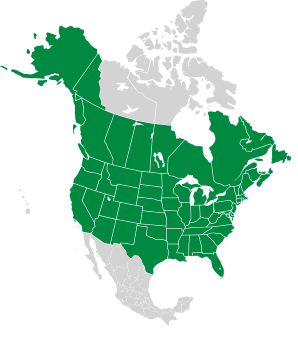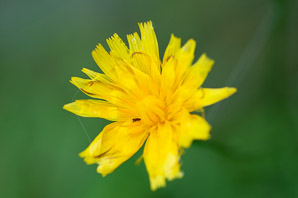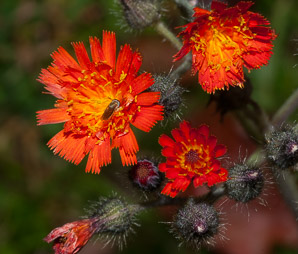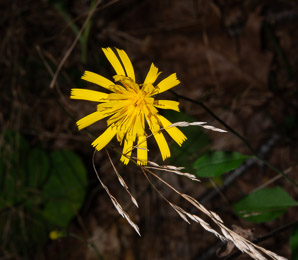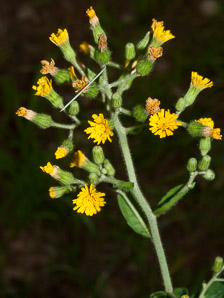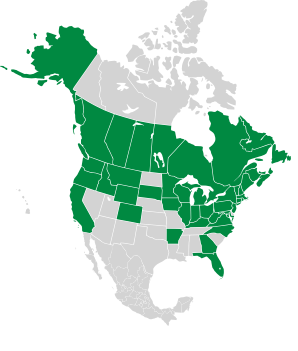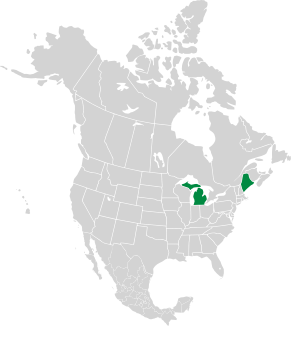
|
Hieracium L. Hawkweed
Some hawkweeds are European imports, originally intended for gardens, now escaped and widespread throughout North America. Others are natives. Especially in the Pacific northwest, some of the imports are considered invasives. Pliny the Elder believed that hawks fed on hawkweeds to improve their otherwise dull eyesight. This results in both the common and genus names. Hieracium derives from Greek hierakion, or "hawk." Hawks in fact have incredibly precise vision. There is no evidence that they pay any attention to these plants, nor, as far as I was able to find, is there anything in hawkweeds that might improve vision. Hawkweeds are apomictic, reproducing asexually—new plants are near-perfect genetic clones of their parents. Most plants, by contrast, reproduce sexually, so that offspring reflect a mixture of traits from both parents. Since hawkweeds are asexual, they change more slowly than other species, but other agents of evolution, such as mutation, still result in changes. These more subtle changes produce microspecies, sometimes in numerous variations, bedevilling those of us with a penchant for classifying plants. Not to mention those of us struggling to invent the science of genetics:
Identification: Hawkweeds typically consist of a basal rosette of leaves, with long stems that are sometimes bare or sometimes contain alternate leaves. Leaves vary a lot in shape. Stems and leaves are usually hairy, sometimes very hairy. When cut or broken, hawkweed stems, leaves, and stolons produce a bitter milky sap. Hawkweeds form patches or colonies, spreading by stolons (above-ground roots) or by seed. Flowers usually occur in clusters and are composed of ray flowers that have squared-off tips and several serrations at the end of each ray. Most are yellow; one species is orange. Flowers are replaced by pappi, round balls containing seeds like those of dandelions; sometimes the pappi are shaped more like an old-style shaving brush. Each seed has its own parachute for wind dispersal. Online References:
Msuextension.org (PDF) Www.eddmaps.org Key to Identification of Invasive and Native Hawkweeds (Hieracium spp.) in the Pacific Northwest (PDF) Here are some hawkweeds and similar-appearing species: |
Yellow hawkweed (Hieracium) · 8/2/2008 · Bar Harbor, Maine · ≈ 3½ × 2½″ (9.8 × 6.6 cm) Orange hawkweed (Hieracium aurantiacum) · 9/29/2012 · Franconia Notch Area, New Hampshire · ≈ 4½ × 3″ (11 × 7.9 cm) Canada hawkweed (Hieracium canadense) · 9/29/2013 · Compass Harbor, Acadia National Park, Bar Harbor, Maine · ≈ 5 × 8″ (12 × 19 cm) Gronovius’ hawkweed (Hieracium gronovii) · 7/31/2012 · Bemis Rd Conservation Area, Pepperell, Massachusetts · ≈ 6 × 4″ (15 × 10 cm) |
||||||||||||||||||||||||||
|
| |||||||||||||||||||||||||||
Hieracium aurantiacum |
Hieracium caespitosum |
Hieracium canadense |
|||||||||||||||||||||||||
|---|---|---|---|---|---|---|---|---|---|---|---|---|---|---|---|---|---|---|---|---|---|---|---|---|---|---|---|
| Common Name |  |
 |
 |
||||||||||||||||||||||||
| Plant | Plants are 8-24″ (20-60 cm) high. Leaves and stems produce a milky latex when broken. | Plants consist of a basal rosette with 3-8 or more leaves, and many tall, thin relatively bare flower stems 10-36″ (25-91 cm) high. Stems, leaves, and stolons exude a milky latex when cut. Stems have dense hairs 1/32-⅛″ (1-4 mm) long, softer toward the bottom, stiffer toward the top. | Plants are 6-60″ (15-152 cm) in height, with leafy stems, the lower part of which have long hairs. Upper stems are fuzzy. Stems, leaves and stolons secrete a milky latex when cut. | ||||||||||||||||||||||||
| Flowers | Bright orange (the only orange hawkweed), with paler orange centers, in small clusters atop tall stems. Flower rays have squared-off, serrated tips. Flowers are ½-¾″ (1.3-1.9 cm) around. | Stems are topped with a flat- or umbrella-shaped cluster of 5-30 yellow flowers. Flowers appear from May to August, and are ½-1″ (1.3-2.5 cm) across. | In loosely branched clusters. Each flower is about 1″ (2.5 cm) across, with 30 or more florets. | ||||||||||||||||||||||||
| Leaves | Leaves are mostly at the bottom, spatula-shaped and very fuzzy, up to 5″ (12 cm) long. | Basal leaves are 2-10″ (5-25 cm) long and ½-1¼″ (1.3-3.2 cm) wide. They are variable in appearence, oblong lanceolate to elliptic in shape, with blunt or pointed tips, sometimes toothed. | Alternate, lanceolate to elliptic, smooth and greenish gray on top, hairy and rough below. Leaves are pointed, with sparse, unevenly spaced sharp teeth. Leaves attach directly to stems, sometimes partially clasping the stems. | ||||||||||||||||||||||||
| Range/ Zones |
|
|
|
||||||||||||||||||||||||
| Habitats | Meadows, grasslands, rangelands, pastures, lawns | Fields, disturbed areas, roadsides, spare woodlands. | Fields, sand plains, roadsides, forest edges, cliffs, grasslands, shorelines. | ||||||||||||||||||||||||
| Type | Wild | Wild | Wild | ||||||||||||||||||||||||
| Occurrence | Common | Common | Common | ||||||||||||||||||||||||
Hieracium gronovii
Hieracium murorum
Hieracium paniculatum



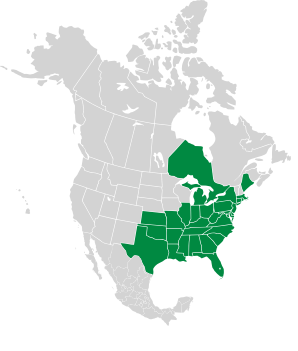
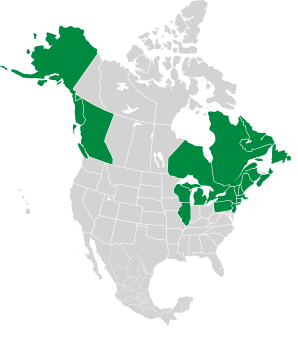
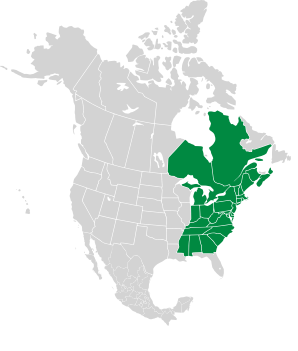
Hieracium pilosella
Lapsana communis


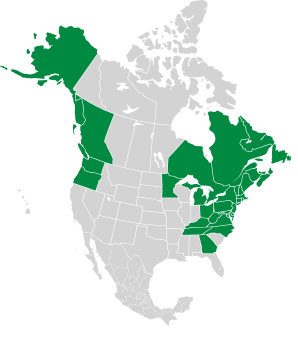
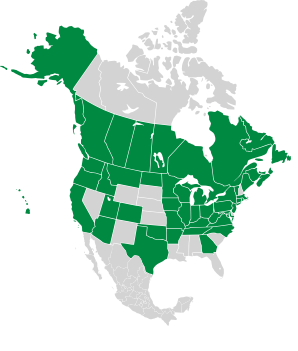
Hieracium description by Thomas H. Kent, last updated 16 Sep 2020.
© FloraFinder.org. All rights reserved.
Range:
